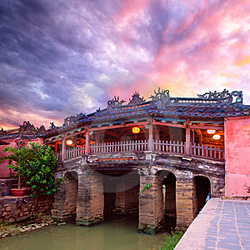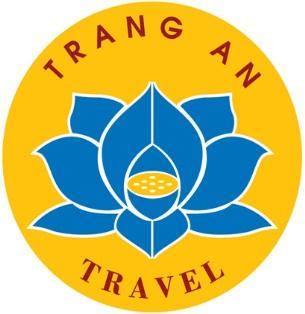Hoi An

No fluorescent lights, no motorcycles, no television. On the 14th day of each lunar month, the riverside town of Hoi An gives modern life the night off.
The ancient town of Hoi An, 30 km south of Danang, lies on the banks of the Thu Bon River . Occupied by early western traders, Hoi An was one of the major trading centers of Southeast Asia in the 16 th century.
Hoi An has a distinct Chinese atmosphere with low, tile-roofed houses and narrow streets; the original structure of some of these streets still remains almost intact. All the houses were made of rade wood, decorated with lacquered boards and panels engraved with Chinese characters. Pillars were also carved with ornamental designs.
Tourists can visit the ralics of the Sa Huynh and Cham cultures. They can also enjoy the beautiful scenery of the romantic Hoi An River, Cua Dai Beach, and Cham Island. Over the last few years, Hoi An has become a very popular tourist destination in Viet Nam.
Light Bright
No flourescent lights. No motorcycles. No television. On the 15th day of each lnar mounth, the riverside town of Hoi An gives modern life the night off
In a wood-fronted shops a woman in traditional dress sist at a desk , bathed in the light of a lantern made from a simple bamboo fishtrap. Outside, two old men are absorbed in a candlelit game of Chinese checkers. These scenes, straight out of the 19th century, still take place in Hoi An, a sleepy riverside town in the central province of Quang Nam
Hoi An has long been a cultural crossroad. More than five centuries ago the Vietnamese nation of Dai Viet expanded its territory southwards, encroaching on the Indianized Kingdom of Champa, which covered much of what is now central Vietnam. Hoi An, located on the Hoai River, emerged when Japanese and Chinese traders built a commercial district there in the 16th century
These diveres cultural influences remain visible today. Visitors will find Hoi An's Old Quarter lined with two-storey Chinese shop, their elaborately caverd wooden facades and moss-covered tile roofs having withstood the ravages of more than 300 years of weather and warfare. These proud old buildings, which back onto the river, remind visitors of another era, when Hoi An's market was filled with wares from as far afield as India and Europe. Colorful guidhalls, founded by ethnic Chinese from Guangdong and Fujian provinces, stand quietly, a testament to the town's trading roost
While Hoi An's old-fashioned charm is alway visible, on the 15th of every lunar month modenrnity takes another step back. On these evenings the town turns off its street lamps and flourescent lights, leaving the Old Quangrter bathed in the warm glow of coloured silk, glass and paper lanterns. In ancient times, Vietnamese people made lamp out of shallow bowl filled with oil. Later, foregn traders introduced lanterns, ranging from round and hexagonal design from China to diamond and star shaped ones from Japan.
Let there be light
W hen developing plans to presrve thei town's ancient character, Hoi An redident decided to revive the practiceof using coloured lanterns. Stating in the fall of 1998, one night each month is declared a "lantern festival".On the 15th day of each lunar month, resident on Tran Phu, Nguyen Thai Hoc, Le Loi and Bach Dang streets switch off their lights and hang cloth and paper lanterns on their porches and windows. Televison sets, radio, street lights and neon lights are turned off
In the enuing quiet the streets of Hoi An are at their most romantic, the danknees broken only by jewel toned lanterns in manner of shapes and sizes.
Strolling through the lantern-lit streets is like walking into a fairytale. It is all the more picturesque since motor vehicles are banned from Hoi An's Old quarter. On Trai Phu Street, stop at the beautifully preserved Faifo Restaurant to sample some traditional Chinese-Style Pastries. Or walk on to the Treated Cafe, where bamboo baskest, commonly used to wash rice, have been tranfomrned into unique lanterns. These basket lamps are but one example of people's creativity as the experiment with new shapes and materials, including lights made from hollow bamboo tubes.
A warm glow.
The 15th day of the lunar monthis a Buddhist day of worship. Rsidents place offerings of food and incense on their ancestral altars and visit one of Hoi An's many pagodas. The scent of incense and the sounds of people singing add to the town's enchanted atmosphere. On these evenings , visitors will get a rare plimpse into another era. These nights are a welcome remnder of life's unexpected beauty.
Hoi An has a distinct Chinese atmosphere with low, tile-roofed houses and narrow streets; the original structure of some of these streets still remains almost intact. All the houses were made of rade wood, decorated with lacquered boards and panels engraved with Chinese characters. Pillars were also carved with ornamental designs.
Tourists can visit the ralics of the Sa Huynh and Cham cultures. They can also enjoy the beautiful scenery of the romantic Hoi An River, Cua Dai Beach, and Cham Island. Over the last few years, Hoi An has become a very popular tourist destination in Viet Nam.
Light Bright
No flourescent lights. No motorcycles. No television. On the 15th day of each lnar mounth, the riverside town of Hoi An gives modern life the night off
In a wood-fronted shops a woman in traditional dress sist at a desk , bathed in the light of a lantern made from a simple bamboo fishtrap. Outside, two old men are absorbed in a candlelit game of Chinese checkers. These scenes, straight out of the 19th century, still take place in Hoi An, a sleepy riverside town in the central province of Quang Nam
Hoi An has long been a cultural crossroad. More than five centuries ago the Vietnamese nation of Dai Viet expanded its territory southwards, encroaching on the Indianized Kingdom of Champa, which covered much of what is now central Vietnam. Hoi An, located on the Hoai River, emerged when Japanese and Chinese traders built a commercial district there in the 16th century
These diveres cultural influences remain visible today. Visitors will find Hoi An's Old Quarter lined with two-storey Chinese shop, their elaborately caverd wooden facades and moss-covered tile roofs having withstood the ravages of more than 300 years of weather and warfare. These proud old buildings, which back onto the river, remind visitors of another era, when Hoi An's market was filled with wares from as far afield as India and Europe. Colorful guidhalls, founded by ethnic Chinese from Guangdong and Fujian provinces, stand quietly, a testament to the town's trading roost
While Hoi An's old-fashioned charm is alway visible, on the 15th of every lunar month modenrnity takes another step back. On these evenings the town turns off its street lamps and flourescent lights, leaving the Old Quangrter bathed in the warm glow of coloured silk, glass and paper lanterns. In ancient times, Vietnamese people made lamp out of shallow bowl filled with oil. Later, foregn traders introduced lanterns, ranging from round and hexagonal design from China to diamond and star shaped ones from Japan.
Let there be light
W hen developing plans to presrve thei town's ancient character, Hoi An redident decided to revive the practiceof using coloured lanterns. Stating in the fall of 1998, one night each month is declared a "lantern festival".On the 15th day of each lunar month, resident on Tran Phu, Nguyen Thai Hoc, Le Loi and Bach Dang streets switch off their lights and hang cloth and paper lanterns on their porches and windows. Televison sets, radio, street lights and neon lights are turned off
In the enuing quiet the streets of Hoi An are at their most romantic, the danknees broken only by jewel toned lanterns in manner of shapes and sizes.
Strolling through the lantern-lit streets is like walking into a fairytale. It is all the more picturesque since motor vehicles are banned from Hoi An's Old quarter. On Trai Phu Street, stop at the beautifully preserved Faifo Restaurant to sample some traditional Chinese-Style Pastries. Or walk on to the Treated Cafe, where bamboo baskest, commonly used to wash rice, have been tranfomrned into unique lanterns. These basket lamps are but one example of people's creativity as the experiment with new shapes and materials, including lights made from hollow bamboo tubes.
A warm glow.
The 15th day of the lunar monthis a Buddhist day of worship. Rsidents place offerings of food and incense on their ancestral altars and visit one of Hoi An's many pagodas. The scent of incense and the sounds of people singing add to the town's enchanted atmosphere. On these evenings , visitors will get a rare plimpse into another era. These nights are a welcome remnder of life's unexpected beauty.
Tin tức liên quan
- Vietnamese second most confident in Asia-Pacific about post-pandemic travel: survey (24/6/2022)
- Kayaking in Việt Nam’s most beautiful places (24/04/2021)
- Da Nang tops Google list of 10 trending destinations for 2020
- Explore Vân Long Wetland Nature Reserve in Ninh Bình
- Hà Nội Train Street among Top 8 over-touristed sites (03/12/2019)
- VNAT hosts famtrip to explore sea and island tourism products in Quang Nam and Quang Ngai
- Travel Daily News lists amazing ways to see Viet Nam (21/06/2019)
- Ha Noi serves nearly 14.4 million visitors so far (21/06/2019)
- CNN praises Hoi An as one of the most beautiful towns in Southeast Asia (19/06/2019)
- Quang Ninh has additional sea and island tourism site (14/06/2019)
Tìm kiếm
Tour
Hotel
Keyword
Location
Location
Star
Type







